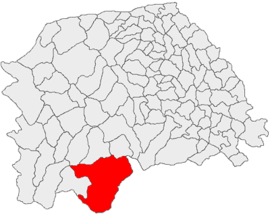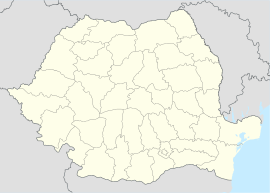world.wikisort.org - Romania
Broșteni is a town in Suceava County, in the historical region of Western Moldavia, northeastern Romania. Broșteni is the fourteenth largest urban settlement in the county, with a population of 5,388 inhabitants, according to the 2011 census. It was declared a town in 2004, along with seven other localities in Suceava County. The town administers the former villages of Hăleasa, Lungeni, and Neagra (which became neighborhoods in 2004), and Cotârgași, Dârmoxa, Frasin, Holda, Holdița, and Pietroasa (with the status of associated villages).
Broșteni | |
|---|---|
Town | |
 Saint Nicholas Wooden Church in Broșteni | |
 Coat of arms | |
 Location in Suceava County | |
 Broșteni Location in Romania | |
| Coordinates: 47°14′39″N 25°41′53″E | |
| Country | Romania |
| County | Suceava |
| Government | |
| • Mayor (2020–2024) | Alexandru Hurjui[1] (PRO) |
| Area | 424.40 km2 (163.86 sq mi) |
| Population (2011)[2] | 5,506 |
| • Density | 13/km2 (34/sq mi) |
| Time zone | EET/EEST (UTC+2/+3) |
| Vehicle reg. | SV |
| Website | www |
| Year | Pop. | ±% |
|---|---|---|
| 2002 | 6,603 | — |
| 2011 | 5,388 | −18.4% |
| Source: Romanian census data | ||
History
Broșteni is a former mining community located on the banks of the river Bistrița, between Bistrița Mountains and Stânișoara Mountains. It administers a total area of 424.40 km2 (163.86 sq mi) – the largest area being administered by a single locality in Suceava County. The national road between Vatra Dornei and Piatra Neamț is the main communication way for Broșteni, which is not connected to the national railway system.
Natives
- Mihai Băcescu
Gallery
- Broșteni, during the early 20th century
References
- "Results of the 2020 local elections". Central Electoral Bureau. Retrieved 9 June 2021.
- "Populaţia stabilă pe judeţe, municipii, oraşe şi localităti componenete la RPL_2011" (XLS). National Institute of Statistics.
External links
- (in Romanian) Broșteni Town Hall official site
- (in Romanian) The Local Police Station of Broșteni
- (in Romanian) A blog about Broșteni
- (in Romanian) Broșteni, orașul cu de-a sila – Newspaper article about Broșteni
- (in Romanian) Suceava County site – Broșteni web page
На других языках
[de] Broșteni
Broșteni ist eine Stadt im Kreis Suceava in Rumänien. Gemessen an der Fläche ist Broșteni die größte Stadt in Rumänien.[3]- [en] Broșteni, Suceava
[ru] Броштени
Броштени, Броштень (рум. Broșteni) — город в южной Буковине в румынском жудеце Сучава.Другой контент может иметь иную лицензию. Перед использованием материалов сайта WikiSort.org внимательно изучите правила лицензирования конкретных элементов наполнения сайта.
WikiSort.org - проект по пересортировке и дополнению контента Википедии

